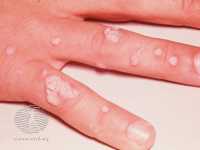
20 Jun A Painless Heat Patch May Help Resolve Warts
MedicalResearch.com Interview with:
Richard J. Antaya, MD, FAAD, FAAP
Professor, Dermatology and Pediatrics
Yale University School of Medicine
MedicalResearch.com: What is the background for this study?
Response: Localized hyperthermia has been reported to hasten the resolution of warts and treat both benign and malignant neoplasms. Numerous clinical studies employing various methods to increase the cutaneous surface temperature, including: infrared radiation, radiofrequency, Nd:YAG laser, moxibustion, warm water immersion, ultrasound, and exothermic heat patches, have all yielded positive results.
We published a proof-of-concept, open-label trial, representing the largest experience to date employing chemical reaction induced exothermic heat patches for the treatment of warts. Localized hyperthermia from all sources currently has a low level of evidence and strength of recommendation because of the lack of well-designed, sufficiently powered studies.
MedicalResearch.com: Is HPV sensitive to heat?
Response: It is not clear whether HPV is sensitive to heat, and if so, if it is sensitive to a specific temperature range. We do not know the exact mechanism of action, but multiple lines of evidence suggest that local hyperthermia results in upregulation of various proteins and cytokines that aid the immune system in wart recognition and enhance apoptosis of HPV-infected keratinocytes.
MedicalResearch.com: What are the main findings?
Response: An exothermic patch, which rapidly warms the skin to 42-43°C after its chemical contents are exposed to oxygen, was applied to one designated “target wart” for a minimum of 2 hours daily for 12 weeks. The target wart and other untreated warts were observed for another 12-week period immediately following the treatment period, for a total study duration of 24 weeks. At the end of study, at week 24, 46.7% of target warts achieved complete clearance and 53.3% decreased more than 50% in size. The efficacy of the heat patches in this trial was similar to that of other wart treatments like cryotherapy, salicylic acid, cantharidin and imiquimod. [Sterling JC, Gibbs S, Haque, et al. British association of dermatologists’ guidelines for the management of cutaneous warts. 2014. Br J Dermatol 2014, Oct;171(4):696-712 and Dvortezky I. Hyperthermia therapy for warts utilizing a self-administered exothermic patch. Dermatol Surg. 1996;22:1035-39.]
One surprising observation was that when the target wart resolved, other untreated warts resolved as well, suggesting a systemic immunological mechanism of action. No local or systemic adverse events were observed. The majority of participants had a positive impression of the treatment. They often applied the patch at home, often at bedtime, providing a convenient and painless treatment option.
MedicalResearch.com: What should readers take away from your report?
Response: The exothermic heat patch studied in this trial appears to be a safe, painless, easy-to-apply treatment, which appears to be as effective as many other common wart treatments. The efficacy was statistically significantly higher in younger participants, the population for whom painful treatments are anathema?
MedicalResearch.com: What recommendations do you have for future research as a result of this work?
Response: We are currently conducting a larger confirmatory study, evaluating the safety and efficacy of the exothermic heat patches. This is a two-arm study, attempting to elucidate the most efficient treatment regimen. Preliminary results are promising, but because we have neither completed this trial nor analyzed the final data, I cannot disclose more information. We hope to publish the results early next year.
Disclosures:
As reported in the April 2019 JDD publication, I have been a consultant for and received an unrestricted grant from Ferndale Pharma Group, Inc.
Citation:
Antaya RJ, Fraile Alonso MDC, Sukumar N, Li FY, Dvoretzky I. An open label study of an occlusive heat patch in the treatment of warts. J Drugs Dermatol. 2019;18(4):368-373.
[wysija_form id=”3″]
[last-modified]
The information on MedicalResearch.com is provided for educational purposes only, and is in no way intended to diagnose, cure, or treat any medical or other condition. Always seek the advice of your physician or other qualified health and ask your doctor any questions you may have regarding a medical condition. In addition to all other limitations and disclaimers in this agreement, service provider and its third party providers disclaim any liability or loss in connection with the content provided on this website.
Last Updated on June 21, 2019 by Marie Benz MD FAAD

